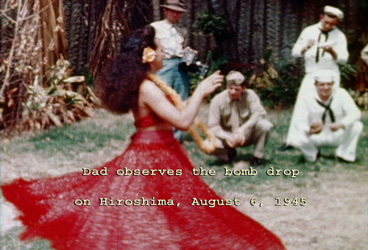Leslie Thornton, Stills from Let Me Count the Ways 10…9…8…7…6, 2004- .
Born 1951 in Oak Ridge, Tennessee; lives in New York, New York
Leslie Thornton’s short films combine original and archival footage, video and still images, and digital media in their investigation of the collision (and collusion) of these modes. The play that she exercises between abstract and referential imagery allows her to address moral and ethical issues as they pertain to events and as they relate to the role of art and media. By editing together controversial or transgressive material, she creates discursive cinematic spaces in which to consider humanity’s inexplicable behaviors, as do fellow avant-garde filmmakers Chris Marker and Chantal Akerman. Yet Thornton’s signature inclusion of sublimely beautiful footage pitted against the tragic lends her oeuvre what she describes in an interview in Afterimage as an “ambiguity of intentions” inspired by a favorite film, Luis Buñuel’s Land without Bread (Tierra sin pan; Las Hurdes) (c. 1932).
Thornton’s employment of footage relating to Hiroshima and the atomic age, elucidating her preoccupation with anxiety, trauma, and culpability, derives in part from her grandfather’s and her father’s roles in developing the atomic bomb and from her up-close childhood experience of the Cold War. Thornton’s artworks often examine the ways technological advancements, from warfare to commercial media, dominate American and global culture. Included in the 1995 Whitney Biennial was a portion of her sixteen-episode epic Peggy and Fred in Hell (1985–2007), which integrates film, video, and installation “environments” to focus on two children traversing an apocalyptic terrain. That work’s episodic methodology is reflected in her current work in progress, Let Me Count the Ways (2004– ).
Let Me Count the Ways is at present composed of five short segments compressed into a 22-minute exploration of the lead-up to, the confusion about, and the aftereffects of the Hiroshima bombing. The title simultaneously references the countdown to the dropping of the bomb and suggests anticipation. Minus 10 juxtaposes footage of the artist’s father in Los Alamos and on the way to Tinian Island with an interview with a woman in Japanese about the bombing. Minus 9 aligns an American nurse’s eyewitness account of the bombing and its aftermath with aerial landscape shots blocked by a blinking blue circle which could represent a mutant sun, an eye, planet Earth, an afterimage, or the inverted “rising sun” of Japanese national symbolism. Minus 8 and Minus 7 show excerpts from a documentary, The Growth of Plants (c. 1950), overlaid by running text describing radiation-induced botanical mutations. Minus 6explores current American war policies and ethics contrasted against the histrionics of Adolf Hitler; as the dictator gesticulates on-screen, women’s voices recite a diatribe by Joseph Goebbels. In recalling past histories of warfare, Thornton’s current work urges the reexamination of contemporary politics, and artistic practice, by building delicately balanced emotional and narrative arguments. TRINIE DALTON
Leslie Thornton, Stills from Let Me Count the Ways 10…9…8…7…6, 2004- . Video, color, sound; 22 min. Collection of the artist

























